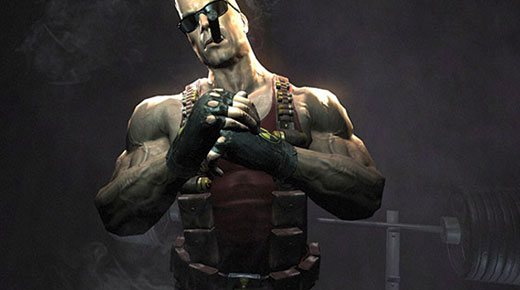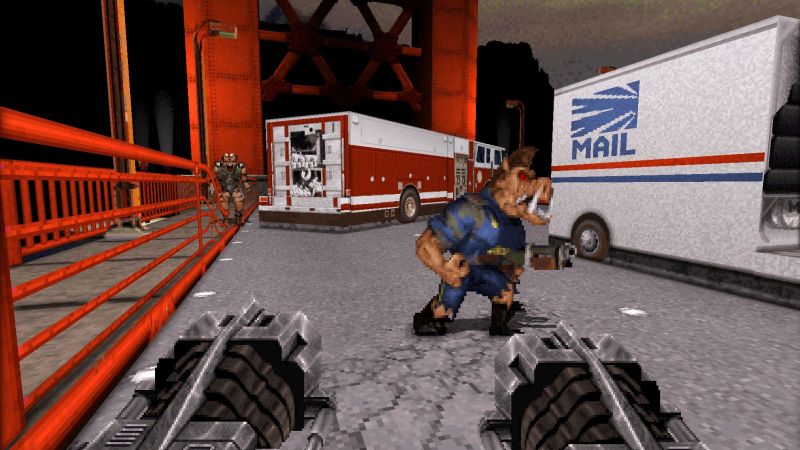
During the height of the franchise’s popularity, Duke Nukem symbolized a very traditionally masculine sense of cool. Duke Nukem is a badass, and he’s better than you, and he can take on anything. While they got their start computers rather than on consoles, the Duke Nukem franchise’s reputation easily precedes itself. We’ll discuss more about the franchise in this video, and evaluate any known plans for the future of the franchise.
The franchise first got its start with the eponymous Duke Nukem in 1991. The franchise is most known for 3D level progression much in the same way that Doom or Quake games play, but it actually got its start as a 2D scrolling platformer. wherein the player navigates Duke to the end of the level, all the while managing his health bar and collecting enhancements for health or weapons, It was a game whose story is told in three episodes, with Duke Nukem pursuing the evil Dr. Proton through Los Angeles, a base on the moon, and in the future in the first, second, and third episodes, respectively.
This game was followed up by Duke Nukem II in 1993, and would be another 2D scrolling platformer, following Duke Nukem as he fights against an evil alien race who seek to take over the Earth across four episodes, each with eight levels. The game features four different kinds of usable weapons. Visually it shares great resemblance to the first game, but mission progression differs noticeably, and features interactable environments such as climbing across pipes as part of playing through stages. Interestingly, besides releasing on computers, it also released for the GameBoy Color, and offered a different gameplay experience altogether – a different enemy alien race, fewer stages, but different weapons, and in this game, Duke Nukem can hang onto ledges.
It would be with Duke Nukem 3D that the franchise and its reputation would really take off. It’s the franchise’s first first-person-shooter, and sits amongst a pantheon of pivotal computer FPS’s such as Quake, Doom, and Wolfenstein 3D for their popularizing of 3D shooter action games. Compared to games such as Quake or Doom, Duke Nukem 3D is noticeably less linear, with destructible stage elements and the ability to interact with environmental elements such as climbing through air ducts.
Duke Nukem 3D also incorporates game design ideas that noticeably differ it from its franchise predecessors, such as a portable medkit that allows Duke Nukem to himself at will. Another evolution of note from its predecessors for the series is the introduction of online multiplayer, in line with the other computer-based popular shooters of the day. Players can play on levels used in the main scenario or on levels made by the level editor included with the game – the same one used by the game’s developers, and the option for co-operative progression through the game’s main scenario was also an option. Duke Nukem 3D, and the first two Duke Nukem games, have all been developed by the same company – while 3D Realms is listed as the developer for Duke Nukem 3D, it is also the name that Apogee Software took on after 1996.
And while Duke Nukem 3D would be followed up by a host of other spinoffs following its release, there would not be a proper sequel for quite some time – not until 2011, with Duke Nukem Forever. Not that this was intended to be the case – as it was initially announced back in 1997, but was delayed and even one officially cancelled at one point in 2009 – though development continued in spite of that. 3D Realms, responsible for the development of the influential Duke Nukem 3D, did not end up completing the game themselves, but Triptych Games and Gearbox Software would finish the job, with Triptych containing some personnel from original Duke Nukem developers 3D Realms. Duke Nukem Forever features interesting deviations from past games, including the way health works – first, Duke Nukem’s ego bar must be depleted, and then his health bar can be depleted.
Duke Nukem Forever was also treated to a DLC expansion called The Doctor Who Cloned Me, an additional scenario campaign featuring the villain Dr. Proton from the first Duke Nukem game. While Forever left the door open for a sequel, the reviews for the game were negative across the board, with the game being seen as dated both in its gameplay design and regressive or offensive in its humor. It was also seen as a weak gameplay experience, plagued by poor controls and too long loading times. The game plays slowly despite trying to harken back to the shooters that 3D released alongside (and despite not containing more movement sophistication associated with more modern shooters, such as cover mechanics,).
This all said and done, it would turn out that Duke Nukem Forever holds the longest ever development time for a video game, a time marked by repeated releases of promotional media – 14 years and 44 days. Rather than a strong return to form, the game is mostly known for a comically long development time and for being disappointing upon release.
The Duke Nukem franchise has also been host to a variety of spinoff games. Releasing in 1998 on the Playstation is Duke Nukem: Time To Kill. This game was not developed by 3D Realms, but by n-Space. Following that in 1999 for the Nintendo 64 is Duke Nukem: Zero Hour, developed by Eurocom – known for their work on certain 007 titles. However, while 007 Goldeneye is seen as an N64 classic, this game released to mediocre reviews.The last main spinoff for the Duke Nukem franchise would be Duke Nukem: Manhattan Project, originally releasing for PC in 2002. It is a game that plays in 2.5D, and allows for the player to focus zoom on either the environment or on enemies, and at times allowing the use of jetpack for traversal.
While Duke Nukem Forever teased a seqyel, the future doesn’t seem good for another new game at all. In a statement dated April 2017, Gearbox made it clear that they have no plans to work on another Duke Nukem game anytime soon, after discussing Duke Nukem’s cameo appearance in Bulletstorm. It’s a rather strange turn of fate for a franchise littered with cancelled projects, signaling the once great interest in continuing the life of the franchise. The voice actor for Duke Nukem, outright stated in a Twitter post at the end of this past January that there is nothing in the works for Duke Nukem.
We can hope that the fates of the character change in the future, but in order to do so, the character very likely has to evolve and find a place in the modern gaming landscape, rather than playing to gameplay experiences or humor sensibilities associated with the past. What do you think is needed for a new Duke Nukem game to succeed? While there are a variety of other shooter franchises that are active, Duke Nukem is notable for being both a shooter and placing heavy emphasis on its protagonist. Let us know in the comments section below. As always – thanks for reading.
















